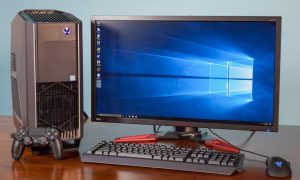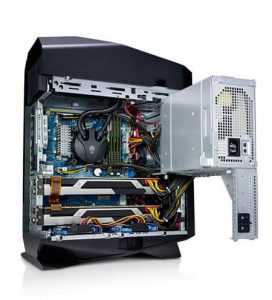

Besides the latest CPU processor Intel has to offer, the Aurora R7 has the ability to support adequate performance cooling methods, overclocking, maintains two full-sized graphics cards, customizable AlienFX lighting, and it's beautiful chassis features hassle-free upgradability without any tools. The factor of great upgradability is not something to consider lightly, as most gamers and serious computing experts devour the thought of being able to swap out hardware whenever they want. This is probably why many PC and tower enthusiasts enjoy building their own machines, per their own idealism and performance standards. The difference here, is the need for technical know, which is quite low.


As mentioned, this is customizable, and as innovative as it may sound, it is. In the case of Alienware’s Aurora R7, there is a quite authentically-designed PSU swing arm, which keeps graphics and expansion cards safely secured and easily upgradable. Speaking of internal hardware, as stated, the CPU provided is an Intel core 8th gen 8700 at 3.2GHz, with a turbo speed of 4.6GHz and 6 cores. The GPU options start at an AMD Radeon RX 560, up to an Nvidia GTX 1080Ti. There's the option of 8GB to 32GB of RAM, a 512GB SSD, and up to a 2TB hard drive. Hence, playing games, and gauging UHD 4K LCD screen performance is nothing but practical on this machine.
The Aurora R7, since it happens to be an upgrade to the R6, does have a strikingly similar port layout, but that’s great because it is plentiful. With a USB-C right at the front, however, this differentiates it from other Dell towers, such as the XPS Tower and MSI Infinite, as having one closer for easy charging is incredibly helpful. Finally, there are 3 USB 3.1 ports, and a headphone/microphone jack in the front. The back includes an incredible six USB 2.0s, four USB 3.1s, and yes, another USB-C just for fun. A full suite of audio ports, Ethernet, HDMI, and 3 DisplayPorts are also available in the rear for all the connections or peripherals you could possibly imagine, dependent on your choice of graphics card.
Along with everything else that makes this machine so personable and easily configurable, it can also handle 4K and VR. Starting at $799.99, this is a “no boundaries” machine, packed with power, and is designed to keep cool. Its “zero-fat design” is the first of its kind, where upgrading graphics, hard drives, and memory are a breeze for the user.

 Laptop & Tablet Parts
Laptop & Tablet Parts




















